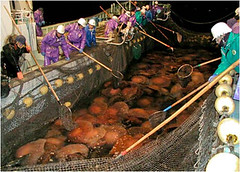聯合國發表最新報告,主張應將「水母潮」納入漁業管理策略規劃的考量。報告指出,過度捕魚造成的水母大量增生,是地中海和黑海漁獲量減少的因素之一。
聯合國糧農組織「地中海一般漁業委員會」發表《地中海和黑海水母潮現況探討》(Review of Jellyfish Blooms in the Mediterranean and Black Sea)報告指出,過度捕魚讓海中的主要掠食者減少,形成水母繁殖的理想環境。
「顯然人類對海洋生態系統的所作所為需要有所調整,以預防和解決水母潮或類似問題。」報告作者Ferdinando Boero在報告中寫道。
Boero教授是動物學及海洋生物學家,主持義大利Salento大學Lecce分校動物學和海洋生物實驗室,同時也是Salento大學環境博物館的科學協調人和義大利動物學期刊主編。
 Boero在報告中詳述了水域中水母數量增加所引發的惡性循環。水母數量增加導致更多魚卵和魚苗被水母捕食,並和魚類競爭食物來源,對已經因濫捕而數量減少的魚類生存更加不利。
Boero在報告中詳述了水域中水母數量增加所引發的惡性循環。水母數量增加導致更多魚卵和魚苗被水母捕食,並和魚類競爭食物來源,對已經因濫捕而數量減少的魚類生存更加不利。
報告中引述專家的預測,如果此趨勢持續下去,水母可能取代魚類在世界海洋中的地位,海洋將從「魚類的天下變成水母的天下」。
除了過度捕撈外,Boerno也提到全球暖化擴大了熱帶地區水母物種的活動範圍,大量興建、用來防止海岸侵蝕的防波堤甚至成為部分水母物種的理想棲息地。
「整體而言,濫捕和全球暖化可說是造成水母在全球海洋中大量生長的主要原因,在地中海和黑海也是如此。」 Boero寫道。
「膠狀浮游生物是典型刺胞動物門生物(如真正的水母)、櫛水母動物門生物(如櫛水母)和尾索動物亞門生物(如樽海鞘)的總稱。膠狀浮游生物的生命週期有利於水母潮的產生,只要環境條件適合,往往能繁衍出龐大的數量。此種膠狀浮游生物大量增生的現象,古時候就已為人知,是海洋的正常功能。」
「不過過去十年,膠質浮游生物大量增生現象越來越常登上媒體版面,多半是因為數千名遊客被水母螫咬,水母吃魚卵和魚苗對漁獲量造成負面影響甚至傷害,膠狀物阻礙海岸植物生長等。」
另外,發電廠和其他海岸邊廠房的入水口也會不時吸入大量水母,被迫暫停運轉,將水母清理出來。在日本、菲律賓、中國、印度、波羅的海、阿曼灣、卡達、波斯灣和美國都曾發生此問題。
其實人類早在1980年代就已見識到水母的衝擊,當時 ,一種常出沒於大西洋、俗稱海胡桃(sea walnut)的淡海櫛水母 (Mnemiopsis leidyi),意外引入黑海後大規模增生,嚴重衝擊魚群數量,讓漁民大感吃不消。 「這種水母一般出沒於美國大西洋岸,可能是被郵輪的壓艙水意外帶入黑海,就像偷渡一樣。」Boero在報告中寫道。
1989年是淡海櫛水母爆發最高峰的一年,達到每立方公尺海水就有400隻、或每立方英尺10隻以上的程度。水母不只會吃掉商業價值相當高的鯷魚仔稚魚,連鯷魚的食物來源也一併吃掉。這問題直到其天敵,另一種入侵種櫛水母Beroe ovata,引入黑海之後,問題才解決。
2007年11月,甚至有一大群佔據約26平方公里面積的水母,吃掉北愛爾蘭10萬隻養殖鮭魚,造成150萬美元左右的損失。
在各種預防或處理水母潮的方法中,這份報告特別建議把水母作食物或藥材方面的運用。例如在中國,可食用的海蜇(Rhopilema esculentum)就是水母的一種,已經成為一項價值數百萬美元的海鮮產業。另外像號稱「常生不死」的燈塔水母( Turritopsis nutricula),因具有「反轉老化過程」的能力,也被視為研發人類抗老藥物的亮點之一。
Jumps in jellyfish populations following overfishing is one reason why fish in the Mediterranean and Black seas are declining, finds a new United Nations report that advocates factoring jellyfish "blooms" into fisheries management strategies.
Overfishing removes top predators from the sea, helping to create ideal conditions for jellyfish blooms, according to the report, "Review of Jellyfish Blooms in the Mediterranean and Black Sea," published by the UN Food and Agriculture Organization's General Fisheries Commission for the Mediterranean.
"It is clear that a new type of human approach to marine ecosystems in general is needed to prevent and face a phenomenon such as the jellyfish blooms," writes the report's author, Ferdinando Boero.
A zoologist and marine biologist, Professor Boero heads the Laboratory of Zoology and Marine Biology at the University of Salento in Lecce, Italy. He serves as scientific coordinator of the Environment Museum of the university and as editor in chief of the Italian "Journal of Zoology."
In the FAO report Boero describes how an increased number of jellyfish in the waters creates a "vicious cycle" where the jellyfish increasingly prey on fish eggs and larvae, and compete for the same food source as the fish populations already depleted by overfishing.
If the trend continues, jellyfish could supplant fish in the world's oceans, according to experts cited in the report who write of "a global regime shift from a fish to a jellyfish ocean."
In addition to overfishing, Boero notes the impact of global warming which enables the species that thrive at tropical latitudes to increase their range, and the prevalent use of sea walls, built to prevent coastal erosion, which are ideal habitats for some jellyfish species.
"Overall, overfishing and global warming are probably the most important drivers of increased jellyfish presence in the global ocean and, with due exceptions, also in the Mediterranean and the Black Sea," writes Boero.
"Gelatinous plankton is formed by representatives of Cnidaria (true jellyfish), Ctenophora (comb jellies) andTunicata (salps)," writes Boero. "The life cycles of gelatinous plankters are conducive to bloom events, with huge populations that are occasionally built up whenever conditions are favorable. Such events have been known since ancient times and are part of the normal functioning of the oceans."
"In the last decade, however, the media are reporting on an increasingly high number of gelatinous plankton blooms," he writes in the report. "The reasons for these reports is that thousands of tourists are stung, fisheries are harmed or even impaired by jellyfish that eat fish eggs and larvae, coastal plants are stopped by gelatinous masses."
Power plants and other industries on coastlines can suck masses of jellyfish into their intake water pumps. The presence of jellyfish forces the plants to stop functioning to clear their pipes, a problem that has affected facilities in Japan, Philippines, China, India, Baltic Sea, Gulf of Oman, Qatar, the Arabian [or Persian] Gulf, and the United States.
The impact of jellyfish was demonstrated in the early 1980s when Mnemiopsis leidyi, a jellyfish species known as the "sea walnut" and normally resident in the Atlantic Ocean, was accidentally introduced into the Black Sea and had such "overwhelming" impact on fish populations that fisheries were put "on their knees."
"This species is typical of the Atlantic coast of the USA, and was probably brought to the Black Sea as a clandestine passenger in the ballast waters of US oil tankers," Boero writes.
By 1989, the population reached its highest level with some 400 specimens per cubic meter of water or more than 10 animals per cubic foot of water. The jellyfish ate up a commercially important type of , preying on the larvea and young, as well as on the anchovy's food source.
The problem was resolved after another invader species, the Beroe ovata, which feeds on Mnemiopsis, also arrived in the Black Sea.
In November 2007, a 10-square-mile (26 km2) swarm of the jellyfish wiped out a 100,000 fish salmon farm in Northern Ireland, causing some US$1.5 million worth of damage.
Among other measures to prevent or cope with jellyfish blooms, the report suggests using jellyfish products for food and medicine.
China is among the first countries to process jellyfish for human consumption, particularly the edible Rhopilema esculentum, and is developing a multi-million-dollar seafood business based on jellyfish.
Other jellyfish, such as the "immortal jellyfish" or Turritopsis nutricula, capable of reversing its aging process, exhibit promise in the field of human aging prevention.
※ 全文及圖片詳見:ENS





